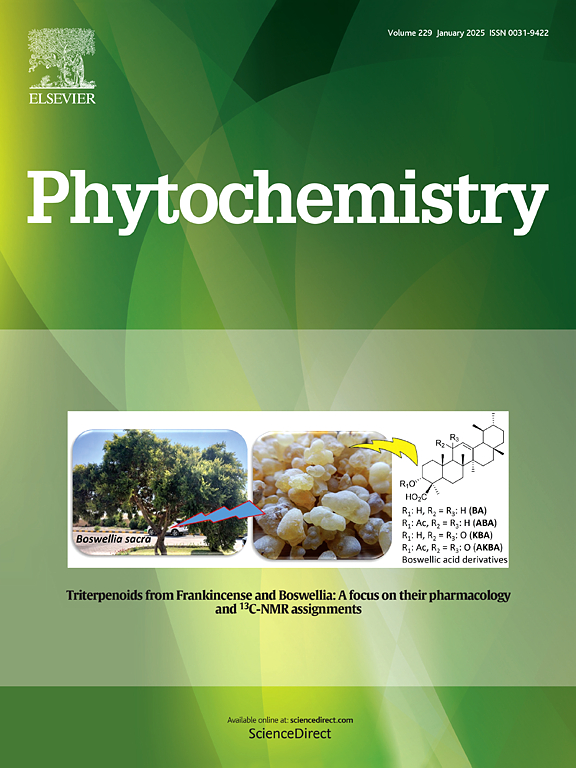The genus Fraxinus L. (Oleaceae): A review of botany, traditional and modern applications, phytochemistry, and bioactivity
IF 3.2
2区 生物学
Q2 BIOCHEMISTRY & MOLECULAR BIOLOGY
引用次数: 0
Abstract
Fraxinus L., a member of the Oleaceae family with approximately 60 species worldwide, is widely distributed in the warm temperate zone of the northern hemisphere. It is not only used as a folk medicine for treating various illnesses but is also documented in medical books. The traditional Chinese medicine "Qin Pi" originated from this genus and is known for its efficacy in treating conditions such as intestinal inflammation, redness and pain in the eyes, abomination of redness and leucorrhoea, and bacterial infections. This paper aims to fill the gap in the existing literature by providing a comprehensive review and critical analysis of the Fraxinus genus plant. The discussion in this paper covers various aspects of the plant, including its botany, traditional and modern applications, phytochemistry, bioactivity, role in ecosystems, phytogenetic evolution, economic benefits, and future challenges. By synthesizing this information, the review aims to offer valuable insights for the advancement, utilization, and further research of the Fraxinus spp.. Phytochemical studies have identified a total of 281 chemical constituents in Fraxinus spp., including secoiridoids, coumarins, and flavonoids. These Fraxinus spp. plants exhibit a wide range of biological activities, such as anti-inflammatory, antioxidant, and antibacterial properties. Furthermore, this paper delves into potential research directions within the genus and addresses the challenges associated with achieving a comprehensive understanding of Fraxinus spp. This paper provides a comprehensive overview of Fraxinus spp., highlighting their bioactivity mechanism and the opportunity to facilitate the advancement of new pharmaceuticals.

石蜡属植物的植物学、传统和现代应用、植物化学和生物活性综述。
白蜡属植物(Fraxinus: L.)广泛分布于北半球暖温带,是油科植物,在世界范围内约有60种。它不仅被用作治疗各种疾病的民间药物,而且在医学书籍中也有记载。中药“秦皮”源于该属,以其治疗肠道炎症、眼睛红肿疼痛、憎恶红肿白带和细菌感染等疾病的功效而闻名。本文旨在通过对黄曲霉属植物的全面综述和批判性分析,填补现有文献的空白。本文讨论了该植物的各个方面,包括其植物学,传统和现代应用,植物化学,生物活性,在生态系统中的作用,植物遗传进化,经济效益和未来的挑战。本文旨在通过对这些信息的综合分析,为黄曲霉属植物的开发利用和进一步研究提供有价值的见解。植物化学研究已鉴定出黄曲霉属植物的281种化学成分,包括环烯醚萜、香豆素和类黄酮。这些黄曲霉属植物具有广泛的生物活性,如抗炎、抗氧化和抗菌特性。此外,本文还深入探讨了该属植物的潜在研究方向,并指出了全面了解曲霉属植物所面临的挑战。本文对曲霉属植物进行了全面的综述,强调了其生物活性机制,并指出了促进新药开发的机会。
本文章由计算机程序翻译,如有差异,请以英文原文为准。
求助全文
约1分钟内获得全文
求助全文
来源期刊

Phytochemistry
生物-植物科学
CiteScore
6.40
自引率
7.90%
发文量
443
审稿时长
39 days
期刊介绍:
Phytochemistry is a leading international journal publishing studies of plant chemistry, biochemistry, molecular biology and genetics, structure and bioactivities of phytochemicals, including ''-omics'' and bioinformatics/computational biology approaches. Phytochemistry is a primary source for papers dealing with phytochemicals, especially reports concerning their biosynthesis, regulation, and biological properties both in planta and as bioactive principles. Articles are published online as soon as possible as Articles-in-Press and in 12 volumes per year. Occasional topic-focussed special issues are published composed of papers from invited authors.
 求助内容:
求助内容: 应助结果提醒方式:
应助结果提醒方式:


